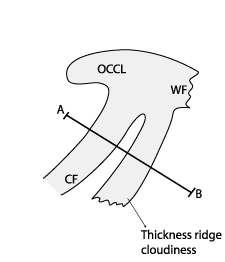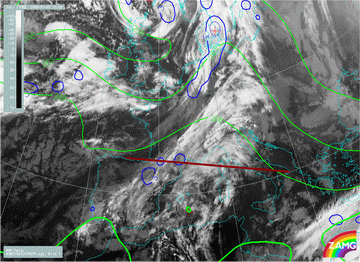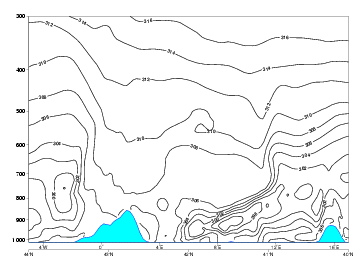Typical Appearance In Vertical Cross Sections
- Isentropes:
A vertical cross section taken across the Cold Front - Thickness Ridge Cloudiness - Warm Front shows the typical frontal gradient of isentropes connected to the Cold Front and Warm Front. In between a maximum of isentropes is observed in the area of the Thickness Ridge Cloudiness. This maximum is an indication of a tongue of warm air. It consists of a maximum of closed isolines in the lower layers indicating unstable conditions. The height of the maximum differs according to the seasons and can be very extreme in summer. The upper part over the maximum has some similarities with an "isentropic trough" usually associated with an Occlusion, but corresponding to a rising warm conveyor belt which is superimposed upon the unstable zone. Depending on the season the layer of the warm conveyor belt can be rather deep. - Temperature advection:
As the Thickness Ridge Cloudiness appears in front of a Cold Front, it generally exists within positive temperature advection (WA) at all levels. This is, in effect, the dominating warm conveyor belt. - Relative humidity:
Although there is a maximum of humidity at the low levels, the rising air of the warm conveyor belt leads to a secondary relative humidity maximum associated with Thickness Ridge Cloudiness in middle and upper levels. - Divergence:
Although there is a distinct convergence maximum in lower levels, there is a broad zone of convergence representing the warm conveyor belt stream at middle and higher levels. - Vertical motion (Omega):
Convergence in lower levels leads to a distinct maximum of upward motion in middle and even higher levels.
|
|
11 April 2008/06.00 UTC - Meteosat 9 IR10.8 image; blue: thermal front parameter (TFP), green: equivalent thickness 500/850 hPa;
position of vertical cross section indicated
|
|
09 January 2008/12.00 UTC - Meteosat 9 IR10.8 image; blue: thermal front parameter (TFP) 500/850 hPa, green: equivalent thickness
500/850 hPa; position of vertical cross section indicated
|
13 January 2008/06.00 UTC - Meteosat 9 IR10.8 image; blue: thermal front parameter (TFP) 500/850 hPa, green: equivalent thickness
500/850 hPa; position of vertical cross section indicated
|
Isentropes, equivalent potential temperature
|
|
11 April 2008/06.00 UTC - Vertical cross section; black: isentropes (ThetaE)
|
The above diagram shows a typical appearance of isentropes associated with Thickness Ridge Cloudiness in summer time. The tongue of warm air represented by a maximum, or at least a bulge of the isentropes within the centre of a vertical cross section, is the most evident feature with Thickness Ridge Cloudiness.
|
|
09 January 2008/12.00 UTC - Vertical cross section; black: isentropes (ThetaE)
|
|
|
13 January 2008/06.00 UTC - Vertical cross section; black: isentropes (ThetaE)
|
The lower of the diagrams shows a common distribution of the isentropes for the winter season, where the warm air tongue is not so strong. The cross-sections show the typical distribution of the isentropes in the summer and the winter season.
Temperature advection
|
|
11 April 2008/06.00 UTC - Vertical cross section; black: isentropes (ThetaE), red thin: temperature advection - CA, red thick:
temperature advection - WA
|
|
|
09 January 2008/12.00 UTC - Vertical cross section; black: isentropes (ThetaE), red thin: temperature advection - CA, red thick:
temperature advection - WA
|
|
|
13 January 2008/06.00 UTC - Vertical cross section; black: isentropes (ThetaE), red thin: temperature advection - CA, red thick:
temperature advection - WA
|
In the upper of the above cross-sections, distinct WA, representing the rising warm conveyor belt, can clearly be seen in the right half of the cross-section. The maximum located at the right-hand side both at lower levels and at upper levels can clearly be linked to the Thickness Ridge Cloudiness.
Relative humidity
|
|
11 April 2008/06.00 UTC - Vertical cross section; black: isentropes (ThetaE), blue: relative humidity
|
|
|
09 January 2008/12.00 UTC - Vertical cross section; black: isentropes (ThetaE), blue: relative humidity
|
|
|
13 January 2008/06.00 UTC - Vertical cross section; black: isentropes (ThetaE), blue: relative humidity
|
A broad zone of increased relative humidity in all levels is connected to the Cold Front, whereas a maximum in the right-hand side of the image, in the upper levels, is connected to the Thickness Ridge Cloudiness.
Divergence
|
|
11 April 2008/06.00 UTC - Vertical cross section; black: isentropes (ThetaE), magenta thick: convergence, magenta thin: divergence
|
|
|
09 January 2008/12.00 UTC - Vertical cross section; black: isentropes (ThetaE), magenta thick: convergence, magenta thin: divergence
|
|
|
13 January 2008/06.00 UTC - Vertical cross section; black: isentropes (ThetaE), magenta thick: convergence, magenta thin: divergence
|
Vertical motion (Omega)
|
|
11 April 2008/06.00 UTC - Vertical cross section; black: isentropes (ThetaE), cyan thick: vertical motion (omega) - upward motion,
cyan thin: vertical motion (omega) - downward motion
|
|
|
09 January 2008/12.00 UTC - Vertical cross section; black: isentropes (ThetaE), cyan thick: vertical motion (omega) - upward
motion, cyan thin: vertical motion (omega) - downward motion
|
|
|
13 January 2008/06.00 UTC - Vertical cross section; black: isentropes (ThetaE), cyan thick: vertical motion (omega) - upward
motion, cyan thin: vertical motion (omega) - downward motion
|
The correspondence between upward motion and THR cloudiness is the best in the last example, where negative values of omega are found in the region of Thickness Ridge. In the first two examples there is hardly any upward motion in the region of the Thickness Ridge.























